
Vabis was the abbreviation and later also trademark of Swedish railway car manufacturer Vagnfabriks Aktiebolaget iSödertälje, which translates Wagon Factory Limited Company of Södertälje, established in 1891 in Södertälje. Vabis also manufactured petrol engines, automobiles, trucks, motor-powered draisines, motorboats and marine engines. The company was in 1911 merged with Maskinfabriks-aktiebolaget Scania, to form Scania-Vabis.

The inline-six engine is a piston engine with six cylinders arranged in a straight line along the crankshaft. A straight-six engine has perfect primary and secondary engine balance, resulting in fewer vibrations than other designs of six or fewer cylinders.

Scania AB, stylised SCANIA in its products, is a major Swedish manufacturer headquartered in Södertälje, focusing on commercial vehicles—specifically heavy lorries, trucks and buses. It also manufactures diesel engines for heavy vehicles as well as marine and general industrial applications.
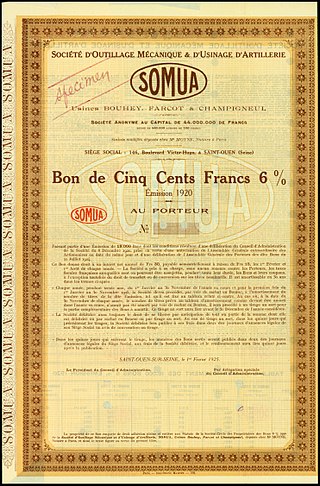
Somua, an acronym for Société d'outillage mécanique et d'usinage d'artillerie, was a French company that manufactured machinery and vehicles. A subsidiary of Schneider-Creusot, Somua was based in Saint-Ouen, a suburb of Paris.
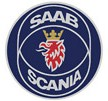
Saab-Scania AB was a Swedish vehicle manufacturer that was formed from the 1969 merger of Saab AB and Scania-Vabis. The company was split in 1995.
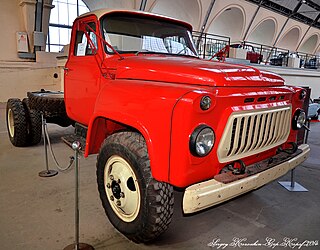
The GAZ-53 is a 3.5 tonne 4x2 truck produced by GAZ between 1961 and 1993. Introduced first as GAZ-53F, it was joined by the virtually identical 2.5-ton GAZ-52 in 1962, which was produced until 1989.
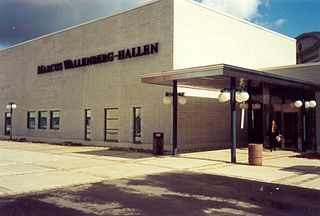
Marcus Wallenberg-hallen is a vehicle museum in Södertälje, in the Swedish province of Sörmland.
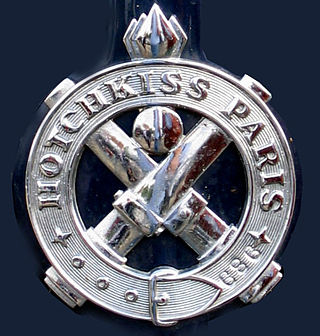
Automobiles Hotchkiss manufactured luxury cars in Saint-Denis, Paris between 1903 and 1955 and trucks between 1936 and 1970. It was a subsidiary of the French company Hotchkiss et Cie. The badge for the marque showed a pair of crossed cannons, evoking the company's history as an arms manufacturer. Hotchkiss also briefly built cars under the Hotchkiss Grégoire brand after the war. Hotchkiss went through a number of mergers and takeovers after the war and the brand disappeared in the 1970s; its successor companies went on to eventually form the partially state-owned Thales Group.

Tidaholms Bruk was a Swedish a vehicle manufacturer. Originally a woodworking and cart manufacturing business founded in the Middle Ages, the company evolved along the centuries and entered the automotive industry with the creation of the Tidaholm car in 1903. Their early models include Tor I, Tor II, and TB, known for their reliability. Facing financial difficulties during the Great Depression, the company eventually closed in the early 1930s. While the company is no longer in operation, it played a significant role in Sweden's automotive history.
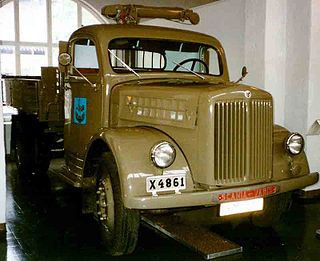
The Scania-Vabis L10/L40/L51 was a series of trucks produced by Swedish automaker Scania-Vabis between 1944 and 1959.

The Scania-Vabis L55/L56/L66 was a series of trucks produced by Swedish automaker Scania-Vabis between 1959 and 1968.
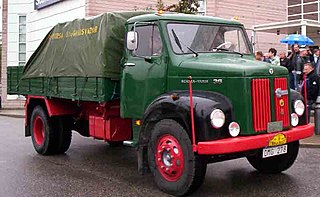
The Scania-Vabis L36 was a medium sized truck produced by Swedish automaker Scania-Vabis between 1964 and 1968.
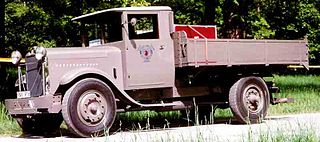
The Scania-Vabis 335/345/355 was a series of heavy duty trucks produced by Swedish automaker Scania-Vabis between 1931 and 1944.

The Scania-Vabis L20/L60/L71 was a series of heavy duty trucks produced by Swedish automaker Scania-Vabis between 1946 and 1958.
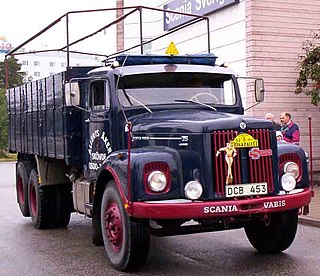
The Scania-Vabis L75/L76 was a series of heavy duty trucks produced by Swedish automaker Scania-Vabis between 1958 and 1968.

The automotive industry in Sweden is mainly associated with passenger car manufacturers Volvo Cars and Saab Automobile but Sweden is also home of two of the largest truck manufacturers in the world: AB Volvo and Scania AB. The automotive industry is heavily dependent on export as some 85 percent of the passenger cars and 95 percent of the heavy vehicles are sold outside of Sweden. The automotive industry and its sub-contractors is a major part of Swedish industry. In 2011 around 110,000 people were employed and the export income of 150 billion SEK accounted for 12 per cent of Sweden's export income. During 2009 128,738 passenger cars and 27,698 heavy vehicles were built in Sweden. Koenigsegg is also a famous Swedish company which makes some of the fastest cars in the world, but also some of the most expensive. They currently produce models such as the Jesko, Gemera, and CC850.

Maskinfabriks-aktiebolaget Scania, translates Machine Factory Limited Company Scania, was a Swedish bicycle manufacturer established in Malmö in 1900. The company rapidly expanded to manufacture other products like precision gears, vacuum cleaners, automobiles, trucks and engines. The company was in 1911 merged with Vabis, to form Scania-Vabis.

Thames was a commercial vehicle brand produced by Ford of Britain.
The Toyota FA and BA were heavy duty trucks introduced in February 1954. They were facelifted versions of the earlier BX/FX trucks, retaining those trucks Type B and Type F six-cylinder petrol engines. The first letter in the model name indicates the engine family fitted; in 1957 the Type D diesel engine was introduced in a model known as the DA. The second letter indicated the size of the truck, with shorter medium duty versions being coded BC/FC/DC. A second letter "B" was used on bus versions of this chassis. A second generation FA/DA was introduced in 1964 and was built in Japan until 1980, when Hino replaced Toyota's heavier truck lines entirely. The DA, however, was also built in numerous other countries and manufacture continued into the first decade of the 21st century.

The early 1930s Renault commercial vehicles were a range of modular chassis produced by Renault, sold under various configurations, primarily trucks, buses and coaches. The range was the first from Renault to get diesel engines and it abandoned previous design styles from the company. The range was gradually replaced from 1935 onwards by the ACx and ADx light range, the ABx medium range and the ZP bus/coach.




















